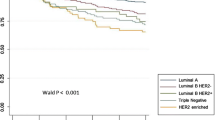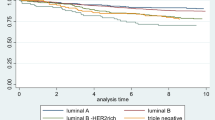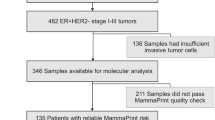Abstract
Introduction Prognostic subgroup classification of operable breast cancers using cDNA clustering of breast cancer-related genes resembles the classification based on the combined immunohistochemical (IHC) expression of the hormone and HER-2 receptors. We here report the short-term disease-free interval (DFI) of operable breast cancers by their joint hormone receptor/HER-2 phenotype. Patients and methods Short-term follow-up (FU) of a prospective cohort of 1,958 breast-cancer patients primary operated at our institution between 2000 and 2005. Receptors were evaluated using IHC. Steroid receptors were considered positive for any nuclear staining; HER-2 for strong (3+) membrane staining or positive fluorescence in situ hybridization (FISH). Kaplan–Meier (KM) DFI curves were calculated for any relapse defined as a local, regional, contralateral, or distant breast cancer event for the six predefined breast cancer subgroups: ER + PR + HER-2 − (PPN), ER + PR − HER-2 − (PNN), ER + PR + HER-2 + (PPP), ER – PR − HER-2 − (NNN), ER – PR − HER-2 + (NNP), and ER + PR − HER-2 + (PNP). P-values were calculated for comparison of the six different survival curves using two possible adaptations for multiple testing. A multivariate model for the receptors predicting DFI did incorporate local and systemic adjuvant therapy. Results Median patient age was 57 years (ranges 26–96) and median FU was 3.35 years. Overall, DFI at median FU was 91%; 94% for PPN, 89% for PNN, 86% for NNN, 81% for PPP, 80% for PNP, and 76% for NNP cases. Some receptor subgroups had a significantly better DFI than others based on multiple testing, especially when the PPN group was compared against the four most frequent subtypes. The multivariate model with local and systemic adjuvant therapy confirmed the prognostic value of ER, PR, and HER-2 for short-term DFI. Conclusion It is possible to distinguish short-term prognostic breast cancer subgroups only on the basis of ER, PR, and HER-2 even when stratified for local and systemic adjuvant therapy. While gene expression profiles based on microarray data of over hundreds of genes will probably teach us much about breast cancer biology, heterogeneity, and prognosis, we emphasize the important short-term prognostic value of currently used IHC markers for ER, PR, and HER-2.


Similar content being viewed by others
References
Jemal A, Siegel R, Ward E et al (2007) Cancer statistics 2007. CA Cancer J Clin 57(1):43–66
Benshushan A, Brzezinski A (2002) Hormonal manipulations and breast cancer. Obstet Gynecol Surv 57(5):314–323. doi:10.1097/00006254-200205000-00024
Lee AH, Ellis IO (2008) The Nottingham Prognostic Index for invasive carcinoma of the breast. Pathol Oncol Res (Jun):10. Epub ahead of print
Constanza ME, Chen WY (2007) Epidemiology and risk factors for breast cancer. Available via www.uptodateonline.com. Accessed 10 Jan 2008
Suen D, Chow LW (2006) Prognostic contribution of the HER-2 oncogene overexpression to the Nottingham Prognostic Index in breast cancer. Biomed Pharmacother 60(6):293–297. doi:10.1016/j.biopha.2006.06.007
Pichon MF, Broet P, Magdelenat H et al (1996) Prognostic value of steroid receptors after long-term follow-up of 2257 operable breast cancers. Br J Cancer 73(12):1545–1551
Cui X, Schiff R, Arpino G et al (2005) Biology of progesterone receptor loss in breast cancer and its implications for endocrine therapy. J Clin Oncol 23(30):7721–7235. doi:10.1200/JCO.2005.09.004
Bardou VJ, Arpino G, Elledge RM et al (2003) Progesterone receptor status significantly improves outcome prediction over estrogen receptor status alone for adjuvant endocrine therapy in two large breast cancer databases. J Clin Oncol 21(10):1973–1979. doi:10.1200/JCO.2003.09.099
Rakha EA, El-Sayed ME, Green AR et al (2007) Biologic and clinical characteristics of breast cancer with single hormone receptor-positive phenotype. J Clin Oncol 25(30):4772–4778. doi:10.1200/JCO.2007.12.2747
Mauriac L, Keshaviah A, Debled M et al (2007) Predictors of early relapse in postmenopausal women with hormone receptor-positive breast cancer in the BIG 1-98 trial. Ann Oncol 18(5):859–867. doi:10.1093/annonc/mdm001
Oh DS, Troester MA, Usary J et al (2006) Estrogen-regulated genes predict survival in hormone receptor-positive breast cancers. J Clin Oncol 24(11):1656–1664. doi:10.1200/JCO.2005.03.2755
Arpino G, Weiss H, Lee AV et al (2005) Estrogen receptor-positive, progesterone receptor-negative breast cancer: association with growth factor receptor expression and tamoxifen resistance. J Natl Cancer Inst 97(17):1254–1261
Huang HJ, Neven P, Drijkoningen M et al (2005) Association between HER-2/neu and the progesterone receptor in oestrogen-dependent breast cancer is age-related. Breast Cancer Res Treat 91(1):81–87. doi:10.1007/s10549-004-8235-8
Kim HJ, Cui X, Hilsenbeck SG et al (2006) Progesterone receptor loss correlates with human epidermal growth factor receptor 2 overexpression in estrogen receptor-positive breast cancer. Clin Cancer Res 12(3 Pt 2):1013s–1018s. doi:10.1158/1078-0432.CCR-05-2128
Clark GM, Osborne CK, McGuire WL (1984) Correlations between estrogen receptor, progesterone receptor, and patient characteristics in human breast cancer. J Clin Oncol 2(10):1102–1109
Park K, Han S, Shin E et al (2007) EGFR gene and protein expression in breast cancers. Eur J Surg Oncol 33(8):956–960. doi:10.1016/j.ejso.2007.01.033
Slamon DJ, Clark GM, Wong SG et al (1987) Human breast cancer: correlation of relapse and survival with amplification of the HER-2/neu oncogene. Science 235(4785):177–182. doi:10.1126/science.3798106
Collett K, Skjaerven R, Maehle BO (1998) The prognostic contribution of estrogen and progesterone receptor status to a modified version of the Nottingham Prognostic Index. Breast Cancer Res Treat 48(1):1–9. doi:10.1023/A:1005945000264
Elzagheid A, Kuopio T, Pyrhonen S et al (2006) Lymph node status as a guide to selection of available prognostic markers in breast cancer: the clinical practice of the future? Diagn Pathol 1:41. doi:10.1186/1746-1596-1-41
Peiro G, Aranda FI, Adrover E et al (2007) Analysis of HER2 by chromogenic in situ hybridization and immunohistochemistry in lymph node-negative breast carcinoma: prognostic relevance. Hum Pathol 38(1):26–34. doi:10.1016/j.humpath.2006.07.013
Schmidt M, Lewark B, Kohlschmidt N et al (2005) Free in PMC Long-term prognostic significance of HER-2/neu in untreated node-negative breast cancer depends on the method of testing. Breast Cancer Res 7(2):R256–R266. doi:10.1186/bcr991
Perou CM, Sorlie T, Eisen MB et al (2000) Molecular portraits of human breast tumours. Nature 406(6797):747–752. doi:10.1038/35021093
Sorlie T, Perou CM, Tibshirani R et al (2001) Gene expression patterns of breast carcinomas distinguish tumor subclasses with clinical implications. Proc Natl Acad Sci USA 98(19):10869–10874. doi:10.1073/pnas.191367098
Kapp AV, Jeffrey SS, Langerod A et al (2006) Discovery and validation of breast cancer subtypes. BMC Genomics 7:231. doi:10.1186/1471-2164-7-231
Carey LA, Perou CM, Livasy CA et al (2006) Race, breast cancer subtypes, and survival in the Carolina Breast Cancer Study. JAMA 295(21):2492–2502. doi:10.1001/jama.295.21.2492
Francis G, Beadle G, Thomas S et al (2006) Evaluation of oestrogen and progesterone receptor status in HER-2 positive breast carcinomas and correlation with outcome. Pathology 38(5):391–398. doi:10.1080/00313020600922488
Sorlie T, Tibshirani R, Parker J et al (2003) Repeated observation of breast tumor subtypes in independent gene expression data sets. Proc Natl Acad Sci USA 100(14):8418–8423. doi:10.1073/pnas.0932692100
Fan C, Oh DS, Wessels L et al (2006) Concordance among gene-expression-based predictors for breast cancer. N Engl J Med 355(6):560–569. doi:10.1056/NEJMoa052933
Pusztai L, Mazouni C, Anderson K et al (2006) Molecular classification of breast cancer: limitations and potential. Oncologist 11(8):868–877. doi:10.1634/theoncologist.11-8-868
Sorlie T, Wang Y, Xiao C et al (2006) Distinct molecular mechanisms underlying clinically relevant subtypes of breast cancer: gene expression analyses across three different platforms. BMC Genomics 7:127. doi:10.1186/1471-2164-7-127
Hannemann J, Kristel P, van Tinteren H et al (2006) Molecular subtypes of breast cancer and amplification of topoisomerase II alpha: predictive role in dose intensive adjuvant chemotherapy. Br J Cancer 95(10):1334–1341. doi:10.1038/sj.bjc.6603449
Eden P, Ritz C, Rose C et al (2004) “Good Old” clinical markers have similar power in breast cancer prognosis as microarray gene expression profilers. Eur J Cancer 40(12):1837–1841. doi:10.1016/j.ejca.2004.02.025
Elston CW, Ellis IO (1991) Pathological prognostic factors in breast cancer. I. The value of histological grade in breast cancer: experience from a large study with long-term follow-up. Histopathology 19(5):403–410
Blamey RW, Ellis IO, Pinder SE et al (2007) Survival of invasive breast cancer according to the Nottingham Prognostic Index in cases diagnosed in 1990–1999. Eur J Cancer 43(10):1548–1555. doi:10.1016/j.ejca.2007.01.016
Cheang MC, Treaba DO, Speers CH et al (2006) Immunohistochemical detection using the new rabbit monoclonal antibody SP1 of estrogen receptor in breast cancer is superior to mouse monoclonal antibody 1D5 in predicting survival. J Clin Oncol 24(36):5637–5644. doi:10.1200/JCO.2005.05.4155
Mohsin SK, Weiss H, Havighurst T et al (2004) Progesterone receptor by immunohistochemistry and clinical outcome in breast cancer: a validation study. Mod Pathol 17(12):1545–1554. doi:10.1038/modpathol.3800229
Harvey JM, Clark GM, Osborne CK et al (1997) Estrogen receptor status by immunohistochemistry is superior to the ligand-binding assay for predicting response to adjuvant endocrine therapy in breast cancer. J Clin Oncol 17(5):1474–1481
Huang HJ, Neven P, Drijkoningen M et al (2005) Association between tumour characteristics and HER-2/neu by immunohistochemistry in 1362 women with primary operable breast cancer. J Clin Pathol 58(6):611–616. doi:10.1136/jcp. 2004.022772
McShane LM, Altman DG, Sauerbrei W et al (2006) REporting recommendations for tumor MARKer prognostic studies (REMARK). Breast Cancer Res Treat 100(2):229–35. doi:10.1007/s10549-006-9242-8
Holm S (1979) A simple sequentially rejective Bonferroni test procedure. Scand J Stat 6:65–70
Benjamini Y, Hochberg Y (1995) Controlling the false discovery rate: a practical and powerful approach to multiple testing. J R Stat Soc [Ser A] B57:289–300
Wolff AC, Hammond ME, Schwartz JN et al (2007) American Society of Clinical Oncology/College of American Pathologists guideline recommendations for human epidermal growth factor receptor 2 testing in breast cancer. Arch Pathol Lab Med 131(1):18
Ciocca DR, Gago FE, Fanelli MA et al (2006) Co-expression of steroid receptors (estrogen receptor alpha and/or progesterone receptors) and Her-2/neu: clinical implications. J Steroid Biochem Mol Biol 102(1–5):32–40
Thomas E, Berner G (2000) Prognostic and predictive implications of HER2 status for breast cancer patients. Eur J Oncol Nurs 4(Sa):10–17
Thomson TA, Hayes MM, Spinelli JJ et al (2001) HER-2/neu in breast cancer: interobserver variability and performance of immunohistochemistry with 4 antibodies compared with fluorescent in situ hybridization. Mod Pathol 14(11):1079–1086. doi:10.1038/modpathol.3880440
Kitano Y, Umemura S, Ohbayashi H et al (2007) Assessment of a new Anti-HER2 monoclonal antibody, SV2-61gamma: a best concordance with HER2 FISH. Appl Immunohistochem Mol Morphol 4:389–393
Ferno M, Haglund M, Bendahl P-O et al (2007) Reproducibility of HER2-analysis in a national survey performed at 24 routine pathology departments in Sweden. Breast Cancer Res Treat 106(1). Special issue: 30th San Antonio breast cancer symposium: abstract 5034
Cleator S, Heller W, Coombes RC (2007) Triple-negative breast cancer: therapeutic options. Lancet Oncol 8(3):235–244. doi:10.1016/S1470-2045(07)70074-8
Francis GD, Dimech MK, Giles L et al (2007) Frequency and reliability of oestrogen receptor, progesterone receptor and HER2 in breast carcinoma determined by immunohistochemistry in Australasia: results of the RCPA quality assurance program. J Clin Pathol 60(11):1277–1283. doi:10.1136/jcp.2006.044701
Layfield LJ, Gupta D, Mooney EE (2000) Assessment of tissue estrogen and progesterone receptor levels: a survey of current practice, techniques, and quantitation methods. Breast J 6(3):189–196. doi:10.1046/j.1524-4741.2000.99097.x
Layfield LJ, Goldstein N, Perkinson KR et al (2003) Interlaboratory variation in results from immunohistochemical assessment of estrogen receptor status. Breast J 9(3):257–259. doi:10.1046/j.1524-4741.2003.09325.x
Schnitt SJ (2006) Estrogen receptor testing of breast cancer in current clinical practice: what’s the question? J Clin Oncol 24(12):1797–1799. doi:10.1200/JCO.2005.05.0666
Banerjee S, Reis-Filho JS, Ashley S et al (2006) Basal-like breast carcinomas: clinical outcome and response to chemotherapy. J Clin Pathol 59(7):729–735. doi:10.1136/jcp.2005.033043
Ferretti G, Felici A, Papaldo P et al (2007) HER2/neu role in breast cancer: from a prognostic foe to a predictive friend. Curr Opin Obstet Gynecol 19(1):56–62. doi:10.1097/GCO.0b013e328012980a
Ponzone R, Montemurro F, Maggiorotto F et al (2006) Clinical outcome of adjuvant endocrine treatment according to PR and HER-2 status in early breast cancer. Ann Oncol 17(11):1631–1636. doi:10.1093/annonc/mdl296
Van Calster B, Vanden Bempt I, Drijkoningen M et al (2008) Axillary lymph node status of operable breast cancers by combined steroid receptor and HER-2 status: triple positive tumours are more likely lymph node positive. Breast Cancer Res Treat 2008(Feb):9. Epub ahead of print
Author information
Authors and Affiliations
Corresponding author
Rights and permissions
About this article
Cite this article
Brouckaert, O., Pintens, S., Van Belle, V. et al. Short-term outcome of primary operated early breast cancer by hormone and HER-2 receptors. Breast Cancer Res Treat 115, 349–358 (2009). https://doi.org/10.1007/s10549-008-0110-6
Received:
Accepted:
Published:
Issue Date:
DOI: https://doi.org/10.1007/s10549-008-0110-6




